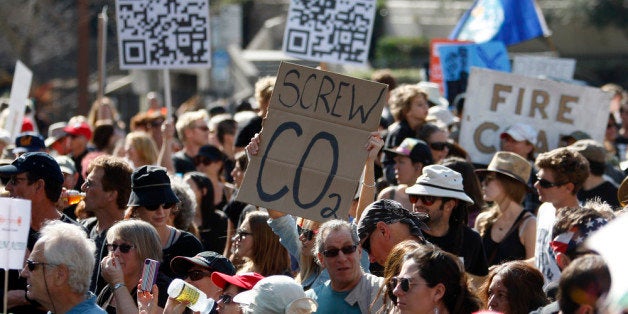
Although 2013 had its share of tragedies (Typhoon Haiyan), portents (reaching the 400 ppm mark for atmospheric CO2) and absurdities (the shutdown of the federal government), it also was in many ways a landmark year for the Sierra Club and the issues we work on. So in this last post of the year, I want to highlight some of the very good things that happened:
In February, the largest climate march and rally in American history filled the National Mall. More than 50,000 people braved one of the coldest days of the year to let President Obama know that we expect him to lead on climate -- starting with a rejection of the Keystone XL pipeline. Not so long ago, the conventional wisdom was that the pipeline was a foregone conclusion. Thousands of grassroots activists have both turned that around and raised national awareness of the dangers of extreme fuels like tar sands.
Earlier that week at the White House, I joined with Sierra Club Board members Allison Chin and Jim Dougherty and several dozen other grassroots environmental leaders in the Sierra Club's first-ever civil disobedience.
In March, President Obama designated five new national monuments, including Rio Grande del Norte in New Mexico and the San Juan Islands in Washington State. Less than a month later, the Senate confirmed his nominee for Secretary of the Interior, Sally Jewell -- a dedicated outdoor enthusiast who understands the economic, recreational and conservation benefits of protecting public lands. Here's hoping that 2014 sees even more ambitious monument designations and protections for public lands.
In June, President Obama delivered a groundbreaking speech that laid out his Climate Plan: "As a president, as a father, and as an American, I'm here to say we need to act." The Obama administration has already followed through on elements of the plan, including ending financing of overseas coal plants, but has much to do in 2014 to meet the obligation and clean energy opportunities identified by the president, particularly by curbing carbon pollution from power plants and by rejecting projects that would expand dirty fuel production, such as the Keystone XL pipeline, drilling in the Arctic and new LNG export terminals.
About those carbon standards: They mean that 2013 is the year that coal-fired power, which was already in decline, lost all hope of a comeback. The EPA not only released draft carbon-pollution standards for new power plants but also held listening sessions on standards for existing power plants -- which were filled with passionate proponents of clean energy. In October, the Sierra Club's Beyond Coal campaign celebrated its 150th coal plant retirement. Eight more retirements have been announced since then. Strong carbon-pollution standards will only accelerate the move away from dirty coal.
Progress in fighting dirty fuels is great, but it's even better when accompanied by a surge in clean energy. Because Congress waited too long to renew the Production Tax Credit, the wind industry got off to a slow start this year, but it's sure booming now, as evidenced by the $1 billion order for turbines placed just this week by Warren Buffett's MidAmerican Energy. Wind is increasingly competitive with both coal and natural gas and, in places like Iowa, is already the least expensive source of new power. In 2014, expect to see more utilities choosing to invest in renewables for mainly economic reasons, as Xcel Power in Colorado did this year.
By the way, falling costs also helped made this a record-breaking year for solar power, with enough new solar electric capacity added to power more than 850,000 average American homes. The Sierra Club's own Solar Home Program has now helped more than 1,000 homes go solar.
There's no way to know exactly what challenges next year will bring, but one thing I am confident about is that we're going to build on all the progress we made this year in replacing dirty fuels with clean energy sources. Here's to a happy renewable year in 2014.
